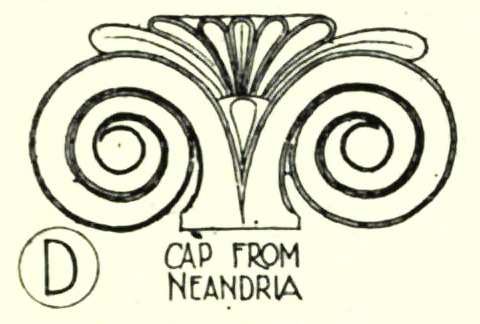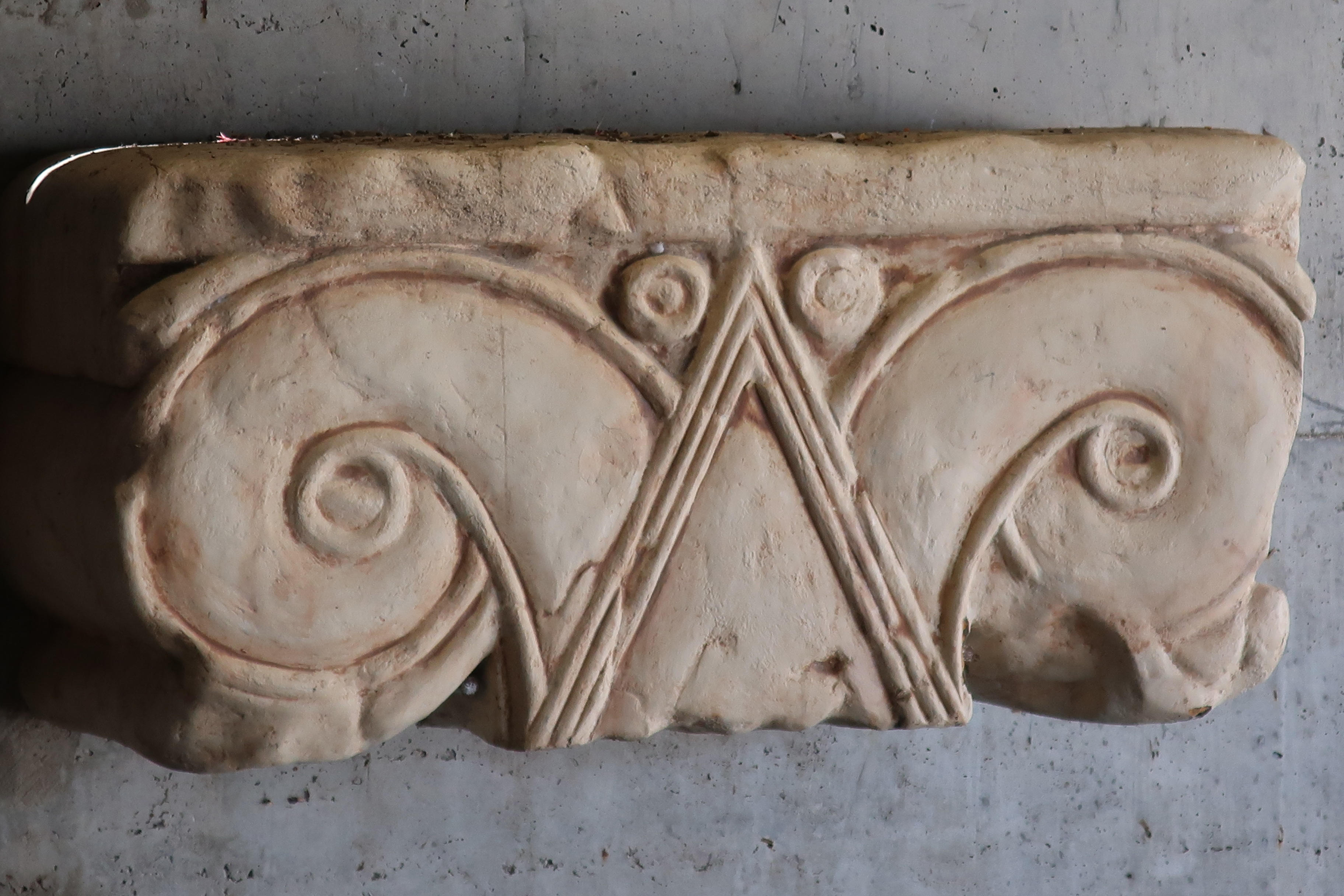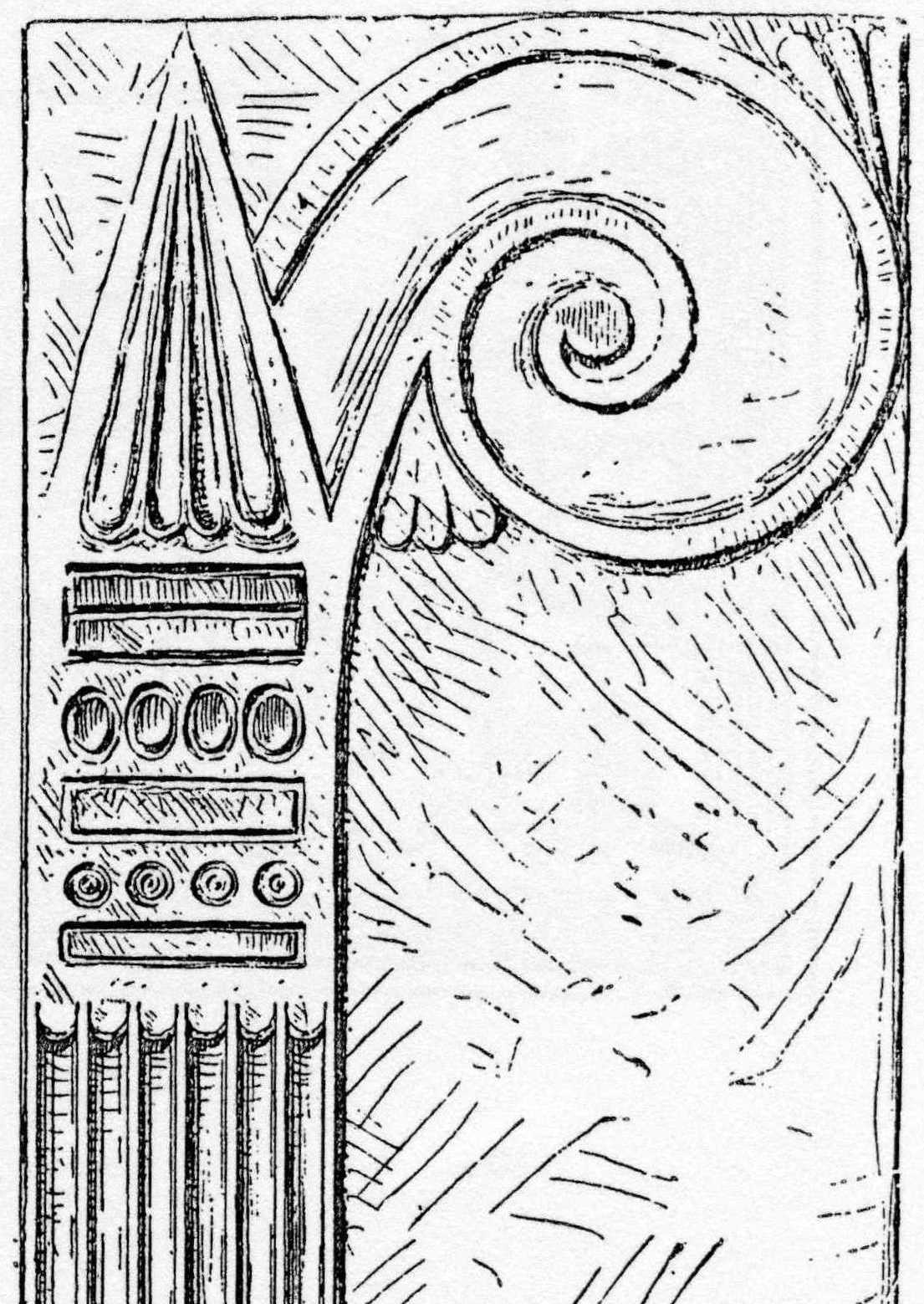Aeolic Order on:
[Wikipedia]
[Google]
[Amazon]
 The Aeolic order or Aeolian order was an early order of
The Aeolic order or Aeolian order was an early order of
 Proto-Aeolic capitals were unearthed in sites in modern-day
Proto-Aeolic capitals were unearthed in sites in modern-day
The Origin and Date of the Volute Capitals from the Levant
in: Finkelstein, Israel and Na'aman, Nadav (eds). ''The Fire Signals of Lachish''. Eisenbrauns (Winona Lake, 2011), pp. 203-225. Accessed 4 September 2020.
''The Art and Culture of Early Greece, 1100-480 B.C.''
p. 132, Cornell University Press, 1987 (rev. edn.), The Aeolic order fell out of use at the end of the Archaic Period.
The Aeolic order fell out of use at the end of the Archaic Period.

Ionic order
Foundation of the Hellenic World. Aeolic order in relation to Ionic and Doric orders, image. Accessed September 2020.
Just a Second: Aeolic Order
The Art Minute: Short Lessons in Art History. Accessed September 2020.
Aeolic Capital
Oxford Reference. Accessed September 2020.
Aeolic capital
The Oxford Companion to Architecture. Accessed September 2020.
Aeolic Order
Archaeologs project. Accessed September 2020.
Architectural Orders
Classical Art Research Centre. Accessed September 2020.
Aeolic-capital
Encyclopædia Britannica. Accessed September 2020.
Proto-Aeolic Capital
Ancient History Encyclopedia Foundation. Accessed September 2020. *Ein Mor, Daniel
Walajeh ('Ain Joweizeh): Preliminary Report
Hadashot Arkheologiyot, Volume 125, Year 2013 (16/06/2013). Proto-Aeolic capital in context: the opening of a water system (tunnel spring) façade. Accessed September 2020.
At popular Jerusalem promenade, archaeologists find a First Temple-era palace
Times of Israel, posted and accessed 3 September 2020. Latest finds of numerous Proto-Aeolic capitals. {{DEFAULTSORT:Aeolic Order Ancient Greek architecture Orders of columns Phoenician architecture
 The Aeolic order or Aeolian order was an early order of
The Aeolic order or Aeolian order was an early order of Classical architecture
Classical architecture usually denotes architecture which is more or less consciously derived from the principles of Greek and Roman architecture of classical antiquity, or sometimes even more specifically, from the works of the Roman architect V ...
. It has a strong similarity to the better known Ionic order
The Ionic order is one of the three canonic orders of classical architecture, the other two being the Doric and the Corinthian. There are two lesser orders: the Tuscan (a plainer Doric), and the rich variant of Corinthian called the composite or ...
, but differs in the capital, where a palmette
The palmette is a motif in decorative art which, in its most characteristic expression, resembles the fan-shaped leaves of a palm tree. It has a far-reaching history, originating in ancient Egypt with a subsequent development through the art o ...
rises between the two outer volute
A volute is a spiral, scroll-like ornament that forms the basis of the Ionic order, found in the capital of the Ionic column. It was later incorporated into Corinthian order and Composite column capitals. Four are normally to be found on an Ion ...
s, rather than them being linked horizontally by a form at the top of the capital. Many examples also show simplified details compared to the Ionic.
"Proto-Aeolic" capitals of Southern Levant
Decorated stone structures reminiscent of the Aeolic order, widely known as "Proto-Aeolic" or "Proto-Ionian" capitals, were especially common in theSouthern Levant
The Southern Levant is a geographical region encompassing the southern half of the Levant. It corresponds approximately to modern-day Israel, Palestine, and Jordan; some definitions also include southern Lebanon, southern Syria and/or the Sinai P ...
during the Iron Age
The Iron Age is the final epoch of the three-age division of the prehistory and protohistory of humanity. It was preceded by the Stone Age (Paleolithic, Mesolithic, Neolithic) and the Bronze Age (Chalcolithic). The concept has been mostly appl ...
. Capitals of this style were discovered in royal buildings and fortified city gates. They were built up for some ashlar masonries, an architectonic style reserved to Israelite
The Israelites (; , , ) were a group of Semitic-speaking tribes in the ancient Near East who, during the Iron Age, inhabited a part of Canaan.
The earliest recorded evidence of a people by the name of Israel appears in the Merneptah Stele o ...
royal structures. One of them is 110 x 28 x 60 cm of dimension and also differs from the canon for its ornamental details, showing a triangular shape in the center as the point of juncture of the capital volutes.
 Proto-Aeolic capitals were unearthed in sites in modern-day
Proto-Aeolic capitals were unearthed in sites in modern-day Israel
Israel (; he, יִשְׂרָאֵל, ; ar, إِسْرَائِيل, ), officially the State of Israel ( he, מְדִינַת יִשְׂרָאֵל, label=none, translit=Medīnat Yīsrāʾēl; ), is a country in Western Asia. It is situated ...
and in the West Bank
The West Bank ( ar, الضفة الغربية, translit=aḍ-Ḍiffah al-Ġarbiyyah; he, הגדה המערבית, translit=HaGadah HaMaʽaravit, also referred to by some Israelis as ) is a landlocked territory near the coast of the Mediter ...
: 27 capitals were discovered in sites belonging to the northern Kingdom of Israel, including Hazor, Megiddo Megiddo may refer to:
Places and sites in Israel
* Tel Megiddo, site of an ancient city in Israel's Jezreel valley
* Megiddo Airport, a domestic airport in Israel
* Megiddo church (Israel)
* Megiddo, Israel, a kibbutz in Israel
* Megiddo Junction, ...
, Dan
Dan or DAN may refer to:
People
* Dan (name), including a list of people with the name
** Dan (king), several kings of Denmark
* Dan people, an ethnic group located in West Africa
**Dan language, a Mande language spoken primarily in Côte d'Ivoi ...
, and Samaria
Samaria (; he, שֹׁמְרוֹן, translit=Šōmrōn, ar, السامرة, translit=as-Sāmirah) is the historic and biblical name used for the central region of Palestine, bordered by Judea to the south and Galilee to the north. The first- ...
, and on Mount Gerizim
Mount Gerizim (; Samaritan Hebrew: ''ʾĀ̊rgā̊rīzēm''; Hebrew: ''Har Gərīzīm''; ar, جَبَل جَرِزِيم ''Jabal Jarizīm'' or جَبَلُ ٱلطُّورِ ''Jabal at-Ṭūr'') is one of two mountains in the immediate vicinit ...
. 11 additional structures were discovered at archeological sites associated with the Kingdom of Judah
The Kingdom of Judah ( he, , ''Yəhūdā''; akk, 𒅀𒌑𒁕𒀀𒀀 ''Ya'údâ'' 'ia-ú-da-a-a'' arc, 𐤁𐤉𐤕𐤃𐤅𐤃 ''Bēyt Dāwīḏ'', " House of David") was an Israelite kingdom of the Southern Levant during the Iron Age. Ce ...
, including the City of David "City of David" is a biblical and religious epithet for the ancient city of Jerusalem.
It may also refer to:
* City of David (archaeological site) - an archaeological excavation associated with ancient Jerusalem
* Jerusalem Walls National Park
...
, Ramat Rachel
Ramat Rachel or Ramat Raḥel ( he, רָמַת רָחֵל, ''lit.'' Rachel's Heights) is a kibbutz located in central Israel. An enclave within Jerusalem's municipal boundaries and overlooking Bethlehem and Rachel's Tomb (for which the kibbutz is ...
and in the 'Ain Joweizeh spring, near Al-Walaja
Al-Walaja ( ar, الولجة) is a Palestinian village in the West Bank, four kilometers northwest of Bethlehem. It is an enclave in the Seam Zone, near the Green Line. Al-Walaja is partly under the jurisdiction of the Bethlehem Governorate ...
. Proto-Aeolic capitals have also been found at archeological sites in modern-day Jordan
Jordan ( ar, الأردن; tr. ' ), officially the Hashemite Kingdom of Jordan,; tr. ' is a country in Western Asia. It is situated at the crossroads of Asia, Africa, and Europe, within the Levant region, on the East Bank of the Jordan Rive ...
: 6 items have been found at sites associated with the kingdom of Moab
Moab ''Mōáb''; Assyrian: 𒈬𒀪𒁀𒀀𒀀 ''Mu'abâ'', 𒈠𒀪𒁀𒀀𒀀
''Ma'bâ'', 𒈠𒀪𒀊 ''Ma'ab''; Egyptian: 𓈗𓇋𓃀𓅱𓈉 ''Mū'ībū'', name=, group= () is the name of an ancient Levantine kingdom whose territo ...
. Fragments of another capital were found in the Amman Citadel, the site of ancient Rabbath Ammon
Amman (; ar, عَمَّان, ' ; Ammonite: 𐤓𐤁𐤕 𐤏𐤌𐤍 ''Rabat ʻAmān'') is the capital and largest city of Jordan, and the country's economic, political, and cultural center. With a population of 4,061,150 as of 2021, Amman is ...
, capital of the Ammon
Ammon (Ammonite: 𐤏𐤌𐤍 ''ʻAmān''; he, עַמּוֹן ''ʻAmmōn''; ar, عمّون, ʻAmmūn) was an ancient Semitic-speaking nation occupying the east of the Jordan River, between the torrent valleys of Arnon and Jabbok, in p ...
ites. The capitals originating in the Kingdom of Israel date to the days of the reign of Omri
Omri ( ; he, , ''‘Omrī''; akk, 𒄷𒌝𒊑𒄿 ''Ḫûmrî'' 'ḫu-um-ri-i'' fl. 9th century BC) was, according to the Hebrew Bible, the sixth king of Israel. He was a successful military campaigner who extended the northern kingdom of ...
in the 9th century BCE, whilst the capitals associated with Judah, Ammon and Moab date to the end of the 8th century or the beginning of the 7th century BCE.
The more appropriate and neutral name "Iron Age volute capitals from the Levant" has been offered. The connection to the Aeolic order, which they precede, is rather complex and probably based on a general use of palm-tree decoration throughout the Ancient Near East
The ancient Near East was the home of early civilizations within a region roughly corresponding to the modern Middle East: Mesopotamia (modern Iraq, southeast Turkey, southwest Iran and northeastern Syria), ancient Egypt, ancient Iran ( Elam, ...
.Lipschits, OdedThe Origin and Date of the Volute Capitals from the Levant
in: Finkelstein, Israel and Na'aman, Nadav (eds). ''The Fire Signals of Lachish''. Eisenbrauns (Winona Lake, 2011), pp. 203-225. Accessed 4 September 2020.
Aeolic order of Asia Minor
The Aeolic form developed in northwesternAsia Minor
Anatolia, tr, Anadolu Yarımadası), and the Anatolian plateau, also known as Asia Minor, is a large peninsula in Western Asia and the westernmost protrusion of the Asian continent. It constitutes the major part of modern-day Turkey. The re ...
, out of Syrian and Phoenicia
Phoenicia () was an ancient thalassocratic civilization originating in the Levant region of the eastern Mediterranean, primarily located in modern Lebanon. The territory of the Phoenician city-states extended and shrank throughout their histor ...
n capitals. It is also seen in some temple
A temple (from the Latin ) is a building reserved for spiritual rituals and activities such as prayer and sacrifice. Religions which erect temples include Christianity (whose temples are typically called churches), Hinduism (whose temples ...
s in Sicily
(man) it, Siciliana (woman)
, population_note =
, population_blank1_title =
, population_blank1 =
, demographics_type1 = Ethnicity
, demographics1_footnotes =
, demographi ...
, and is named from the Aeolian colonies
Aeolian commonly refers to things related to either of two Greek mythological figures:
* Aeolus (son of Hippotes), ruler of the winds
* Aeolus (son of Hellen), son of Hellen and eponym of the Aeolians
* Aeolians, an ancient Greek tribe thought to ...
of northwestern Asia Minor. The earliest surviving examples of the Aeolic order are contemporary with the emergence of the Ionic and Doric order
The Doric order was one of the three orders of ancient Greek and later Roman architecture; the other two canonical orders were the Ionic and the Corinthian. The Doric is most easily recognized by the simple circular capitals at the top of col ...
s in the 6th century BC. Some authorities have suggested that the Ionic style represents a development of the Aeolic, but others disagree.p. 132, Cornell University Press, 1987 (rev. edn.),
 The Aeolic order fell out of use at the end of the Archaic Period.
The Aeolic order fell out of use at the end of the Archaic Period.
Other associated forms
Some Etruscan tombs show a similar capital, with two large volutes that do not lie flat, but no palmette in the centre as in theTomb of the Reliefs
The Tomb of the Reliefs ( it, Tomba dei Rilievi) is an Etruscan tomb in the Banditaccia necropolis near Cerveteri, Italy.
It was discovered in 1847 and has been dated to the end of the 4th century BC. It is a unique example of an Etruscan tomb ...
.
See also
* Aeolic GreekReferences
External links
Aeolic order
*Ionic order
Foundation of the Hellenic World. Aeolic order in relation to Ionic and Doric orders, image. Accessed September 2020.
Just a Second: Aeolic Order
The Art Minute: Short Lessons in Art History. Accessed September 2020.
Aeolic Capital
Oxford Reference. Accessed September 2020.
Aeolic capital
The Oxford Companion to Architecture. Accessed September 2020.
Aeolic Order
Archaeologs project. Accessed September 2020.
Architectural Orders
Classical Art Research Centre. Accessed September 2020.
Aeolic-capital
Encyclopædia Britannica. Accessed September 2020.
Proto-Aeolic capital
Proto-Aeolic Capital
Ancient History Encyclopedia Foundation. Accessed September 2020. *Ein Mor, Daniel
Walajeh ('Ain Joweizeh): Preliminary Report
Hadashot Arkheologiyot, Volume 125, Year 2013 (16/06/2013). Proto-Aeolic capital in context: the opening of a water system (tunnel spring) façade. Accessed September 2020.
At popular Jerusalem promenade, archaeologists find a First Temple-era palace
Times of Israel, posted and accessed 3 September 2020. Latest finds of numerous Proto-Aeolic capitals. {{DEFAULTSORT:Aeolic Order Ancient Greek architecture Orders of columns Phoenician architecture